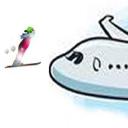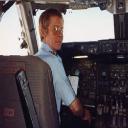Yahoo Answers is shutting down on May 4th, 2021 (Eastern Time) and beginning April 20th, 2021 (Eastern Time) the Yahoo Answers website will be in read-only mode. There will be no changes to other Yahoo properties or services, or your Yahoo account. You can find more information about the Yahoo Answers shutdown and how to download your data on this help page.
Trending News
Questions about SFO crash landing.?
Doesn't an airliner fly mostly on auto-pilot up until right before touchdown?.
There would've been the pilot, co-pilot, and navigator, all watching instruments during the landing, right?
Even without auto-pilot on, surely there are warning lights, and alarms if the plane is coming in too slow/fast, high/low, incorrect flaps etc?
Weather wasn't a problem that I heard. No mayday with mechanical problems.
Doesn't it just seem that with todays advanced aircraft and highly trained pilots, this crash should be impossible?
6 Answers
- Mildred's peopleLv 58 years agoFavorite Answer
The autopilot can be switched off any time the pilots feel like it, depending on how much of the approach they want to hand fly. In the case of Asiana, it was switched off about 1600 feet above touchdown, which definitely falls within "normal" switch off points. There hasn't been a navigator on commercial aircraft for almost 50 years, although there was a third pilot onboard, though it isn't clear if he was in the cockpit or not. Most aircraft today just have two pilots...Captain and First Officer.
As far as the caution warning system is concerned, a 777 is loaded with them. The plane crashed because it stalled, and so the crew did get a stick shaker and probably master caution/warning messages as well. They would not have got GPWS (Ground proximity) messages like "TOO LOW! PULL UP!" because they weren't descending at an abnormal rate, and since the ILS system for runway 28L was out of service, the airplane wasn't able to sense its position on the glide slope signal. The entire approach was visual, hand-flown.
Yes, the crew should have been able to do it....NO PROBLEM. The problem is with the culture of Asia...here it goes, I'm sure I'm going to get thumbs down from some PC sissy. Asian countries have a very high power-distance culture. In other words, an F/O wouldn't DARE challenge the Captain...he'd almost rather crash the plane than cause his Captain to "lose face". It's an attitude that has caused deadly crashes in the past, and Crew Resource Management at Asian carriers is archaic compared to their western and European counterparts. I wouldn't be surprised that the Captain (and the other captain onboard) were taking turns brow beating the young F/O in training, or they were busy stroking each other's egos. In any case, there were NO eyes outside the airplane, and probably a total lack of support to the F/O from either captain. Poor CRM, poor communication, and the fact that the F/O probably misjudged the aaproach angle having recently come from narrow body jets.
Source(s): commercial pilot since 1994 - ?Lv 78 years ago
I really hate it when people second guess or "Monday morning quarterback" ANY event when they don't have all the facts.
What we DO know is 1) The ILS system for this runway was NOT in operation at the time of the crash. 2) the airplane came in too low and too slow for the approach. 3) The tail of the airplane hit the sea wall at the end of the runway just before landing. 4) The pilot flying the airplane was an experienced airline Captain, but this was his first landing at this airport in this type of airplane.
Everything else is just wild speculation, and the only people who REALLY know what happened are the people who were in the cockpit at the time of the crash.
The FAA and the NTSB and every other alphabet group in the UNIVERSE are "investigating" this sad event and we will have a formal report of their findings in about a year. In the meantime, all the ambulance chasing lawyers in the USA are doing their best to make sure that the airline that owned/leased this airplane will never fly in the USA again. Score one more "victory" for the legal process.
- 8 years ago
Interesting question that is very thought provoking about this crash. I the majority of cases, commercial airliners will use the Instrument Landing System to control the approach and glide slope up until they're above the runway threshold (and yes, there is some variation in the timing of that), but in the case of Asiana 214, there were a few special circumstances that I predict, will turn out to be the cause of the crash.
Some of the special circumstances of that flight -
-The captain that was in control of the plane during approach and landing was in training and had roughly 40 hours of experience flying the 777.
-It was that captains first flight into SFO.
-The flight had taken 10 hours, 20 minutes, suggesting the flight crew was likely fatigued and jet lagged.
-MOST IMPORTANTLY, runway 28L, the runway on which Asiana 214 was attempting to land, was in the middle of safety renovations which meant that the ILS was inoperative at the time of the crash and that every plane landing were flying visual approaches meaning that the pilots were in charge of following the correct glide slope, managing the throttle, landing the plane manually, along with everything else they normally would have to do.
Because of these circumstances, the fatigued, and possibly distracted captain, came in way too high and realized he was above the glide slope and thus corrected for this by reducing throttle. He likely reduced the throttle way too much, and for longer than he should have, upon realizing he was then too low, he corrected by pitching up and throtling up, however it was too little too late, as the plane had lost enough airspeed and flared for landing so early that the plane wasn't able to regain speed and climb out of its ill-fated fall. The pilots did call for a go-around, after likely hearing an array of alarms and seeing a panel lit up like a Christmas tree with warnings, however when this occurred they were far to low, slow, and pitched too far up to regain enough speed to climb out before the tail section slammed into the seawall.
This is just a complete guess, with no substantial evidenve, but the fact that the weather was so clear could have also played a role in the crash. Since the captain had never flown into SFO, he could have been distracted witht the mesmerizing sights of San Francisco. Again, that's a complete guess that could be complete malarky in the end.
Source(s): Various news articles and being somewhat familiar with how modern commercial jets operate - Skipper 747Lv 78 years ago
I flew 707, 727, 747 and DC8 in airline service -
The 747 I flew (for 20 years of my life) were able to do an autoland -
The ones with "fail operating" autopilots (3 autopilots) were certified Cat.IIIa -
And obviously also equipped with autothrottle -
I never flew autoland much - I would say once everu 2 or 3 months...?
When maintenance said "please make autoland for operating check" -
I generally (personal preferences) flew departure on autopilot upon flaps retraction -
For approach/landing, I hand flew starting first extension of flaps -
When you are a 747 pilot, you get very little flying practice -
You give half of landings to the first officer...
I generaslly only logged 2, 3 or maximum of 4 landings per month -
So you can understand why 747 (and other long haul pilots) like to handly -
.
Source(s): Retired airline pilot - How do you think about the answers? You can sign in to vote the answer.
- HughLv 58 years ago
No, most landings aren't necessarily done on autopilot. The ILS glideslope was unavailable on that runway, and they were on a visual approach. They should have known if they were too low by the visual approach slope indicator, or precision approach path indicator if that's what that runway at KSFO has.
It sounds like the approach speed was too low, and the aircraft stalled just as the decision was made (too late, IMO) to execute a missed approach procedure, or "go-around", and they didn't have enough altitude to be able to break the stall before reaching the ground.
EDIT: I really hate it when people whine about others playing, "Monday morning quarterback", yet proceed to throw their own speculation out there anyhow. How is it that people who do that are so arrogant as to think only their opinion can be right?
- 8 years ago
Pilots actually use something called an ILS approach which is an auto-pilot system that lines the aircraft on the runway and establishes a glideslope for the aircraft. Usually the pilot disengages the auto-pilot just before he/she is landing the aircraft.





